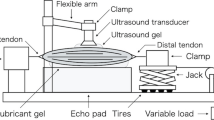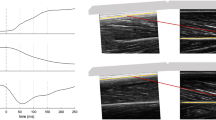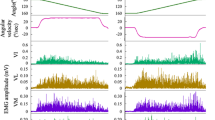Abstract
In this paper the force-length relation of intact, in vivo, human rectus femoris musles were determined experimentally and compared to a corresponding theoretical force-length relation based on the cross-bridge theory. The experimental force-length relation has a much smaller peak force and a much wider range of muscle fiber lengths where non-zero forces were observed than the theoretical relation. Possible reasons for the differences between the two forcelength relations are discussed.
Similar content being viewed by others
References
Benedict JV, Walker LB, Harris EH (1968) Stress-strain characteristics of unembalmed human tendon. J Biomech 1:53–63
Gordon AM, Huxley AF, Julian FJ (1966a) Tension development in highly stretched vertebrate muscle fibres. J Physiol (Lond) 184:143–169
Gordon AM, Huxley AF, Julian FJ (1966b) The variation in isometric tension with sarcomere length in vertebrate muscle fibres. J Physiol (Lond) 184:170–192
Herzog W (1985) Individual muscle force prediction in athletic movements, University of Calgary Printing, Calgary
Herzog W (1988) The relation between the resultants moments at a joint and the moments measured by an isokinetic dynamometer. J Biomech 21:5–12
Herzog W, ter Keurs HEDJ (1988) A method for the determination of the force-length relation of selected in-vivo human skeletal muscles. Pflügers Arch 411:637–641
Huxley AF (1957) Muscle structure and theories of contraction. Prog Biophys Chem 7:255–318
Steindler A (1977) Kinesiology of the human body. Thomas, Springfield, IL
Walker SM, Randolph-Schrodt G (1973) I-segment lengths and thin filament periods in skeletal muscle fibers of the Rhesus monkey and the human. Anat Rec 178:63–82
Wickiewicz TL, Roy RR, Powell PL, Edgerton VR (1983) Muscle architecture of the human lower limb. Clin Orthop 179:275–283
Wilkie DR (1968) Studies in biology, vol 11, Muscle. Edward Arnold Publishers Ltd., London
Author information
Authors and Affiliations
Rights and permissions
About this article
Cite this article
Herzog, W., ter Keurs, H.E.D.J. Force-length relation of in-vivo human rectus femoris muscles. Pflugers Arch. 411, 642–647 (1988). https://doi.org/10.1007/BF00580860
Received:
Revised:
Accepted:
Issue Date:
DOI: https://doi.org/10.1007/BF00580860




